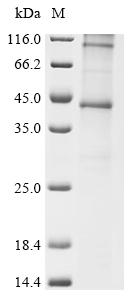Design PCR primers to obtain the full-length sequence of human CCR1 (1-355aa). The 10xHis tag gene is added at the N-terminus of the full-length sequence of human CCR1 to obtain the target gene. The human cDNA is used as a template to amplify the target gene by PCR. The amplified PCR product is digested and ligated with the expression vector to construct a recombinant plasmid. The recombinant plasmid is cultured in an in vitro E.coli expression system to promote protein expression. Collect the supernatant of the culture medium and purify the supernatant by affinity chromatography to obtain the recombinant human CCR1 protein. The purity of the protein exceeds 90% as measured by SDS-PAGE.
The human CCR1 protein plays a crucial role in mediating immune responses by binding to various chemokines, including CCL3, CCL5, and CCL7 [1][2][3]. CCR1 is predominantly expressed on a variety of immune cells, such as monocytes, eosinophils, neutrophils, and T and B lymphocytes, which underscores its importance in leukocyte trafficking and inflammatory responses [4][5][6].
CCR1 is involved in the recruitment of immune cells to sites of inflammation and infection. Studies have shown that CCR1 is essential for the recruitment of NK cells and the production of type-1 cytokines during pulmonary granuloma formation, indicating its role in orchestrating immune responses in the lungs [1]. Additionally, CCR1 has been implicated in modulating responses to various pathogens, including respiratory syncytial virus (RSV), where its expression is altered during viral infections, affecting immune cell dynamics [7][8].
CCR1 also participates in pain modulation and tumor progression. Research has demonstrated that CCR1 influences pain responses through its actions on hematopoietic and non-hematopoietic cells [9]. Furthermore, the CCR1/CCL5 axis has been shown to play a significant role in tumor microenvironments, where it can regulate tumor growth and metastasis by facilitating the recruitment of immune cells to tumors [10][11].
References:
[1] X. Shang, B. Qiu, K. Frait, J. Hu, J. Sonstein, J. Curtis, et al., Chemokine receptor 1 knockout abrogates natural killer cell recruitment and impairs type-1 cytokines in lymphoid tissue during pulmonary granuloma formation, American Journal of Pathology, vol. 157, no. 6, p. 2055-2063, 2000. https://doi.org/10.1016/s0002-9440(10)64844-4
[2] J. Domachowske, C. Bonville, J. Gao, P. Murphy, A. Easton, & H. Rosenberg, The chemokine macrophage-inflammatory protein-1α and its receptor ccr1 control pulmonary inflammation and antiviral host defense in paramyxovirus infection, The Journal of Immunology, vol. 165, no. 5, p. 2677-2682, 2000. https://doi.org/10.4049/jimmunol.165.5.2677
[3] M. Amat, C. Benjamim, L. Williams, N. Prats, E. Terricabras, J. Beleta, et al., Pharmacological blockade of ccr1 ameliorates murine arthritis and alters cytokine networks in vivo, British Journal of Pharmacology, vol. 149, no. 6, p. 666-675, 2006. https://doi.org/10.1038/sj.bjp.0706912
[4] F. Bednar, C. Song, G. Bardi, W. Cornwell, & T. Rogers, Cross-desensitization of ccr1, but not ccr2, following activation of the formyl peptide receptor fpr1, The Journal of Immunology, vol. 192, no. 11, p. 5305-5313, 2014. https://doi.org/10.4049/jimmunol.1302983
[5] R. Phillips, V. Stubbs, M. Henson, T. Williams, J. Pease, & I. Sabroe, Variations in eosinophil chemokine responses: an investigation of ccr1 and ccr3 function, expression in atopy, and identification of a functional ccr1 promoter, The Journal of Immunology, vol. 170, no. 12, p. 6190-6201, 2003. https://doi.org/10.4049/jimmunol.170.12.6190
[6] T. Ness, K. Carpenter, J. Ewing, C. Gérard, C. Hogaboam, & S. Kunkel, Ccr1 and cc chemokine ligand 5 interactions exacerbate innate immune responses during sepsis, The Journal of Immunology, vol. 173, no. 11, p. 6938-6948, 2004. https://doi.org/10.4049/jimmunol.173.11.6938
[7] J. Li, L. Xue, j. wang, A. Meng, J. Qiao, M. Li, et al., Activation of the chemokine receptor ccr1 and preferential recruitment of gαi suppress rsv replication: implications for developing novel rsv treatment strategies, 2022. https://doi.org/10.1101/2022.03.18.484968
[8] A. John, C. Gérard, M. Schaller, A. Miller, A. Berlin, A. Humbles, et al., Respiratory syncytial virus‐induced exaggeration of allergic airway disease is dependent upon ccr1‐associated immune responses, European Journal of Immunology, vol. 35, no. 1, p. 108-116, 2004. https://doi.org/10.1002/eji.200425439
[9] N. Lewis, A. Muthukumarana, S. Fogal, L. Corradini, D. Stefanopoulos, P. Adusumalliet al., Ccr1 plays a critical role in modulating pain through hematopoietic and non-hematopoietic cells, Plos One, vol. 9, no. 8, p. e105883, 2014. https://doi.org/10.1371/journal.pone.0105883
[10] J. Chen, S. Huang, H. Wang, T. Zhao, Y. Song, X. Zhong, et al., Integrated analysis reveals the pivotal interactions between immune cells in the melanoma tumor microenvironment, Scientific Reports, vol. 12, no. 1, 2022. https://doi.org/10.1038/s41598-022-14319-2
[11] S. Ta, R. Fl, O. Hh, S. Watanabe, A. C, S. Fukada, et al., Dual role of ccl3/ccr1 in oral squamous cell carcinoma: implications in tumor metastasis and local host defense, Oncology Reports, 2007. https://doi.org/10.3892/or.18.5.1107






